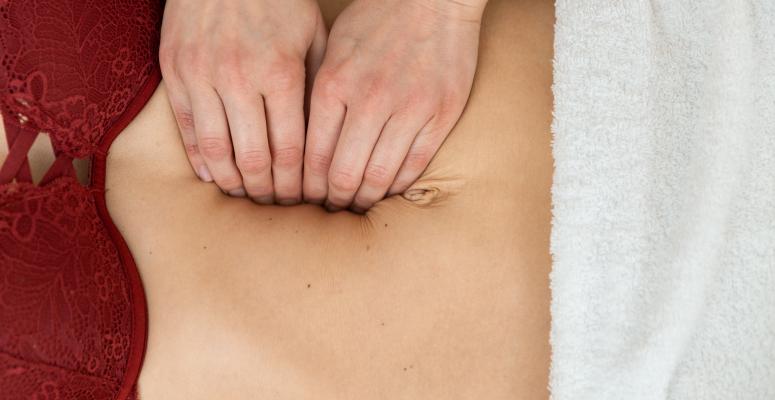
Diastasis recti is a condition that occurs when your rectus abdominis muscles — your core muscles around your belly button — are overstretched to the point that they tear. This condition is commonly found in pregnant women or women who’ve recently given birth. In fact, 60% of women experience diastasis recti during or after pregnancy.
While it’s not usually painful, this condition can cause pelvic and back pain and restricted mobility. So, many people with diastasis recti seek physical therapy to restore their abdominal muscles.
In this article, we’ll explain how to check for diastasis recti and what to do if you think you have it. We’ll also answer some other frequently asked questions related to this condition.
What causes diastasis recti?
Pregnancy puts your abdominal wall under extreme pressure, which puts significant stress on your ab muscles. Estrogen, relaxin and other hormones produced in large quantities during pregnancy relax the muscles, leaving them more susceptible to stretching. Eventually, often during delivery, the muscles are stretched too thin and tear.
Other conditions and activities, such as heavy lifting, can cause diastasis recti. Any activity that puts the abdominal muscles under too much pressure can lead to separation.
How to check for diastasis recti
Checking for diastasis recti is simple. Here’s a quick step-by-step walkthrough:
- Lie flat on your back.
- Bend your knees up toward your body so your feet are flat on the floor.
- Place your index and middle fingers on your belly button pointing toward the floor and press downward.
- Lift your head up while keeping your shoulders flat on the floor.
- If you have diastasis recti, you will feel a gap (wider than your fingers) open up between your abdominal muscles.
Many cases of diastasis recti are visible. It typically, though not always, appears as a bulge that protrudes from the center of your stomach area.
How is diastasis recti diagnosed?
Even after you check for diastasis recti yourself, you should consult a professional for confirmation. They will manually inspect your abdomen to determine whether you have this condition. In some cases, they may want to use an ultrasound to get a clearer picture of your abdominal muscles.
Abdominal gaps vary in size, but anything wider than 2 centimeters is considered diastasis recti. At that point, your doctor may refer you to a physical therapy specialist for treatment. If they don’t but you want to consult a physical therapist, you can ask for a referral or consult one on your own.
What happens if diastasis recti is left untreated?
Some cases of diastasis recti heal themselves within a few months. Other cases worsen as time passes. If left untreated, this condition cause cause several unwanted problems, including:
- Weakened muscles — The abdominal muscles that tear with this condition usually help you to lift heavy objects. Tears in these muscles can make it difficult to do so.
- Pelvic pain — While this condition is not usually painful at first, inflammation can occur if you overstretch your core muscles before they’ve fully healed. This can lead to pain in the hips or pelvis.
- Lower back pain — With weakened core muscles, you put added pressure on your lower back that can lead to pain over time.
- Bladder leakage — Your core muscles support your urinary tract, tightening when you aren’t actively urinating to prevent any leakage. As the core muscles loosen, you may find that you have less control over your bladder.
Can physical therapy help with diastasis recti?
Physical therapy is a commonly recommended treatment for diastasis recti. It can help you strengthen your core muscles to reduce visible symptoms and restore your muscle strength.
Here are a few of the ways physical therapists treat diastasis recti:
- Assessment and evaluation — Your physical therapist will check for diastasis recti to confirm that you in fact have it and then determine a personalized treatment plan that accounts for any specific symptoms you have.
- Strength-building exercises — Physical therapy will help you regain core strength so you can lift objects and move around without discomfort. This can relieve pain in your pelvic area and lower back while reducing bladder leakage.
- Bracing — Your physical therapist may want you to wear a brace to support your abdominal muscles as they heal. They will fit you for one to ensure that your brace is comfortable and flexible to support healing.
- Electrical stimulation — Electrical stimulation is a physical therapy treatment in which small electrical currents are applied to your muscles. These currents increase circulation to your affected muscles to promote healing in that area.
Alliance PTP is ready to help you find top-notch PT for diastasis recti
At Alliance Physical Therapy Partners, we’re proudly bringing together physical therapy practices across the country to help people get the high-quality PT they need. Want to see a physical therapist in person? We can put you in touch with an Alliance PTP partner that’s close to you and that can help you address diastasis recti.
Not keen on in-person PT sessions or not close to an Alliance PTP partner? No worries. We also offer effective and affordable virtual physical therapy through our Agile Virtual Physical Therapy platform.
Contact our team today so we can help you find the most effective physical therapy services for your injury or condition.
Get Help at a Location Near You
